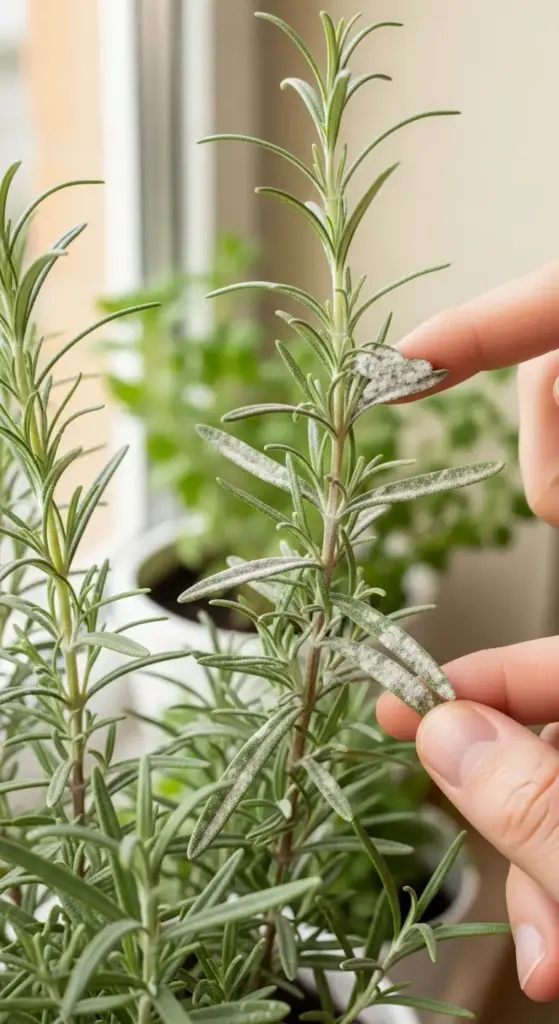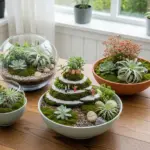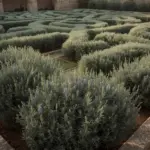3. White Powdery Coating on Leaves (Powdery Mildew)

The first time I saw that white dusty stuff on my rosemary leaves, I honestly thought it was just dust from my apartment. I even tried wiping it off with a damp cloth.
Big mistake. Within a week, that innocent-looking white coating had spread to half my plant, and I was frantically googling “why does my rosemary look like it’s been dusted with flour?”
How to Identify Powdery Mildew vs. Natural Plant Residue
Here’s the thing about powdery mildew identification – it’s sneaky at first. Real dust or residue wipes off easily and doesn’t come back. Powdery mildew feels slightly fuzzy and keeps returning even after you clean it.
The dead giveaway? It starts on the undersides of leaves first. I learned this after flipping over a suspicious leaf and finding this white, web-like coating that definitely wasn’t there yesterday.
Natural plant residue is usually more random – maybe some kitchen grease splatter or actual dust that settles evenly. Powdery mildew has this distinct pattern where it spreads in circular patches that get bigger over time.
Try the finger test: rub the white stuff between your fingers. Dust feels gritty, but fungal spores feel powdery and almost slippery.
Why This Fungal Issue Thrives in Certain Cities
Living in Atlanta taught me why some cities are basically powdery mildew paradise. That combination of high humidity and warm temperatures? It’s like a spa day for fungal spores.
Seattle’s constant moisture creates the same problem, just with cooler temps. My rosemary plants there were constantly battling this white coating, especially during those drizzly months when nothing ever fully dries out.
Cities like Phoenix or Denver? Rarely saw this issue because the air is so dry that fungal spores can’t get established.
The worst combo is high humidity with poor air circulation – think cramped apartment balconies in humid cities where the air just sits there.
I noticed my indoor rosemary plants got hit harder in humid climates because there’s even less air movement inside. That stagnant air is basically a fungal breeding ground.
DIY Treatment Solutions Using Kitchen Ingredients
Okay, this is where I got creative out of desperation. My first DIY powdery mildew treatment was a total disaster – I used straight vinegar and nearly killed the plant.
Here’s what actually works: Mix one tablespoon of baking soda with a few drops of dish soap in a quart of water. Spray it on affected leaves in the evening when the sun won’t burn the wet foliage.
Milk spray sounds weird, but it works. Mix one part milk with nine parts water and spray weekly. Something about the proteins in milk creates an environment that fungal spores hate.
My go-to recipe now? One teaspoon baking soda, one teaspoon vegetable oil, and a tiny drop of dish soap in a quart of water. The oil helps it stick to the leaves better.
Never spray during the heat of the day – learned that lesson when I basically cooked my poor rosemary leaves with a magnifying glass effect.
Prevention Strategies for Apartment and Container Gardeners
Container gardening in apartments makes powdery mildew prevention tricky, but not impossible. The key is air circulation – I run a small fan near my herb collection for a few hours each day.
Spacing is crucial. I used to cram all my herbs together on one windowsill, creating this perfect little humidity bubble. Now I spread them out so air can move between the pots.
Watering technique matters too. I water at soil level now instead of getting the leaves wet. Wet foliage in humid conditions is basically sending an invitation to every fungal spore in the neighborhood.
Choose your container location wisely. South-facing windows with good airflow beat east-facing spots that stay damp longer.
Morning sun is your friend – it helps dry any overnight moisture before fungal spores can get comfortable.
When to Isolate Your Plant from Other Herbs
This was the hardest lesson for me to learn. I’m a optimist by nature, so I kept thinking my infected rosemary would just get better on its own.
Isolate immediately when you first spot that white coating. Don’t wait to see if it spreads – it will, and it’ll take your basil and oregano down with it.
I learned this after losing three perfectly healthy herb plants because I didn’t want to separate my “herb family.” Powdery mildew spores travel through the air, so even a few inches of separation isn’t enough.
Move the infected plant to a different room if possible. If you can’t, at least put it on the opposite side of your growing area with a fan blowing air away from your healthy plants.
Quarantine period should be at least two weeks after you stop seeing new white patches. I usually wait a full month before reuniting plants, just to be safe.
Don’t forget to wash your hands after touching the infected plant. I accidentally spread it to my mint plant by checking on my rosemary and then immediately fussing with other herbs.
The good news? Caught early and treated properly, powdery mildew is totally beatable. My current rosemary plant is thriving after surviving a mild case last spring.
Think you’ve mastered the watering game? Click “next” to discover why your rosemary might be drowning even when the soil looks perfect – and the emergency rescue technique that saved my favorite plant!









GIPHY App Key not set. Please check settings